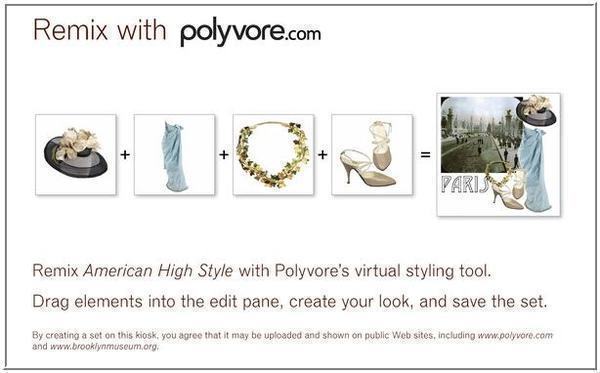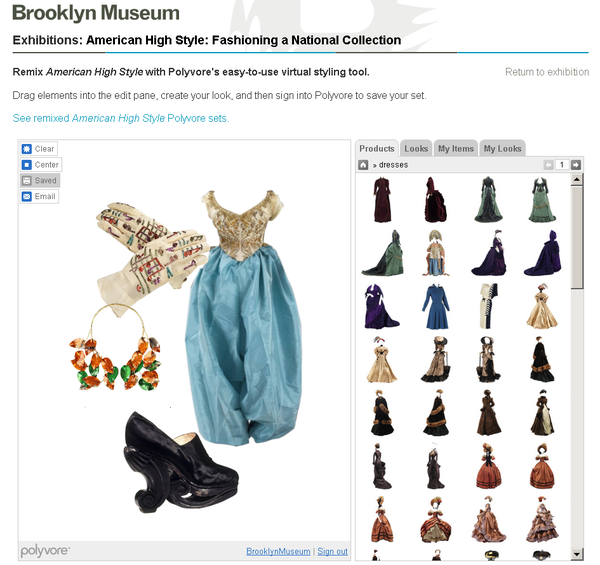Remix American High Style with Polyvore!
I’ll admit that I get inspiration from somewhat odd places and three weeks ago, inspiration struck as I was reading the New Yorker and came across an article on Polyvore. Polyvore is an online fashion community where participants use a virtual styling tool to cut and paste items from the web, then remix them into their own fashion layouts—background images paired with shoes, dresses, accessories to create any number of combinations. Think of it as a web 2.0 Vogue, if you will.
After reading the New Yorker piece, I spent a few hours on Polyvore—in awe—realizing the site was a perfect match for our American High Style exhibition, which opens today. I mean, seriously, we’ve got some great stuff in this show…imagine being able to remix dresses by Charles James, Norman Norell, Gilbert Adrian, Charles Frederick Worth, Elsa Schiaparelli, Jeanne Lanvin, Jeanne Paquin, Madeleine Vionnet, and Christian Dior…sounds pretty exciting, right? In typical Brooklyn Museum tech style, we had very little time to put this together, but I figured an e-mail to the folks at Polyvore couldn’t hurt. Turns out, they thought this was a perfect match too and were excited to work with us.
We started working right away to upload the contents of the exhibition into the styling tool and get various components ready. The online interactive is combined with an in-gallery kiosk and the Polyvore community can remix directly on polyvore.com. As soon as we started to upload, the Polyvore community found our objects and started to use them in layouts. They’ve been very welcoming to us and their love of the site and contents remind me of those early days (2006!) when we first started our Flickr account—people are friendly, chatty and they just love creating. It’s been a joy to be part of this. Take a look at this remix below—I couldn’t help but adore this when I saw it—it’s a favorite movie of mine and that’s our Charles James dress!

katharine hepburn in bringing up baby 1938 by The Bombshell. Check out more sets created by the Polyvore community!
At this point you are probably getting why this is a good pairing, but in addition to the content synergy, it’s worth mentioning that Polyvore has both the tools and the community—both are vital components for us. I often speak about going to community and engaging on their terms and this is a good example of that—we need to be reaching out, where people are and not expecting them to come directly to us. As a museum with a small tech staff, we need to be mindful of any opportunities that come our way that can save us time and coding and Polyvore fits that bill too. Much like the YouTube Quick Capture kiosks we created for another show, this is taking an existing platform and using it both online and in the gallery via a kiosk to create something really dynamic for a exhibition that we couldn’t otherwise. It’s rare to have an opportunity like this one that so beautifully melds all of these objectives, but keeping our eyes open to these possibilities has provided something exciting for our visitors.

Sign, above, located at the in-gallery kiosk. Kiosk is a mac with wkiosk running the Polyvore styling tool.
Quick notes of thanks are due to the team at Polyvore who pulled this together on such short notice—Sukhinder, Milee, Jianing, Katherine and the entire team; Matt, Denise and Christine at the MET for dealing with last minute complications coming across the river on a very tight time frame; Judith, Hali—you rock my legal world; and, Deb, thanks for fast images…again.
In hindsight, it’s a really good thing I had just caught up on my New Yorker reading; this is one time I would have hated to be my typical week or so behind!

Shelley Bernstein is the former Vice Director of Digital Engagement & Technology at the Brooklyn Museum where she spearheaded digital projects with public participation at their center. In the most recent example—ASK Brooklyn Museum—visitors ask questions using their mobile devices and experts answer in real time. She organized three award-winning projects—Click! A Crowd-Curated Exhibition, Split Second: Indian Paintings, GO: a community-curated open studio project—which enabled the public to participate in the exhibition process.
Shelley was named one of the 40 Under 40 in Crain's New York Business and her work on the Museum's digital strategy has been featured in the New York Times.
In 2016, Shelley joined the staff at the Barnes Foundation as the Deputy Director of Digital Initiatives and Chief Experience Officer.

